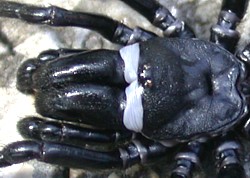|
|
ARTHROPODS:
Insects»
Spiders»
Centipedes»
Millipedes»
Sowbugs»
Harvestmen»
Mites
& Ticks»
Scorpions»
Identification
Tips»
About
the Critter Files»
Links» |
|
|
|
 |
PURSEWEB
SPIDERS
Critter
Files/Spiders/Purseweb Spiders
By Blake Newton
University of Kentucky Department of Entomology |
| |
|
| Purseweb
Spiders are medium-sized, dark-colored spiders characterized
by their oversized chelicerae. Like wolf
spiders, purseweb spiders have a low stance and sprawling legs,
but in addition to their larger chelicerae, the common purseweb
spiders in Kentucky are shiny black, whereas most wolf spiders are
hairy and brown. And, like all spiders, purseweb spiders have
8 legs and 2 main body segments (cephalothorax and abdomen).

Purseweb spider cephalothorax.
Note large chelicerae
(B. Newton 2003)
|
|
| SIZE:
Body length up to about 1 1/4" |
| |
| LIFE
CYCLE |
|
Simple
metamorphosis: like all spiders, young purseweb spiders hatch from
eggs and look like tiny adults. They shed their skin as they
grow. Male purseweb spiders will often wander long distances
in search of females. |
| ECOLOGY |
|
Purseweb spiders are
predators. Like most spiders, they feed on insects, smaller
spiders, and similar creatures. But purseweb spiders have
a very unusual hunting strategy. Instead of building a large,
sprawling web like orb-weaver and cobweb spiders (for instance),
purseweb spiders build a compact, upright silk tube. The spider
hides inside the tube, and when prey lands on the outside, the spider
bites through the silk and pulls the meal inside.
Ed Nieuwenhuys, who maintains
some of the best spider-related pages on the Internet, has a diagram
showing the purseweb spider hunting technique at this website:
http://www.xs4all.nl/~ednieuw/Spiders/Atypidae/Atypidae.html
Although purseweb spiders
are fierce predators, they are sometimes prey, and are fed upon
by small mammals, birds, and other spiders. |
| |
| PEST
STATUS |
|
Purseweb
spiders are rarely encountered and they are not pests. Like
many spiders, they can bite, but they are not considered dangerous
except to individuals who are highly sensitive to spider and insect
bites. |
| |
| COMMON
KENTUCKY PURSEWEB SPIDERS |
|
There are
a few species of purseweb spiders found in Kentucky, but their secretive
habits make them difficult to find. |
|
|
ATYPUS
sp.
GENUS: Atypus
In the spring and early
summer, males of the Atypus genus are
sometimes seen on trails and roads. The one pictured below
was photographed in Bath County, Kentucky, in the Daniel Boone National
Forest. |
| |
 Male purseweb
spider in the Atypus genus. (B. Newton, 2003)
Male purseweb
spider in the Atypus genus. (B. Newton, 2003) |
|
| |
| COLLECTING
& PHOTOGRAPHY |
|
Except for wandering
males, which are somewhat slow-moving and easy to photograph, purseweb
spiders are very rarely seen outside of their silken tubes. The
webs are often found at the bases of trees or rocks. The best way to preserve purseweb spiders (and most spiders) is by storing them in ethyl alcohol. Purseweb spider males make good photo
subjects: they will sometimes stand still for a picture when
they are found moving around outside of their webs.
|
| |
| PURSEWEB
SPIDER FACTS |
|
Although purseweb
spiders resemble wolf spiders, they
are not closely related. In fact, purseweb spiders, along
with trap-door spiders, are very primitive spiders, and they are
the closest relatives to tarantulas that live in Kentucky. Wolf
spiders are not related to tarantulas.
The Red-Legged Purseweb Spider (Sphodros
rufipes, which may occur in Kentucky) has historically appeared on U.S. endangered species lists, but some scientists believe that it may not be a rare spider.
|
| |
| MYTHS
- LEGENDS - FOLKLORE |
|
Do you know any myths,
legends, or folklore about these spiders? If so, let us know.
|
Original document: 25 May 2004
Last updated: 21 Apr 2008
Photos courtesy R.
Bessin and B. Newton, University of Kentucky
The Kentucky Critter Files are maintained
by Blake Newton, Department of Entomology, University of Kentucky.
Contact: blaken@uky.edu |
|

